25 Overused Eco-Friendly Terms (And What They Actually Mean)
As an Amazon Associate, Ecotero earns from qualifying purchases.
This is a comprehensive guide to commonly used eco-friendly terms and their meanings.
As you make the switch to a more eco-conscious lifestyle, you will come across various jargon around the eco-friendly community.
Terms like sustainably-sourced, zero waste, certified organic, bio-based, or Fair Trade on product labels might get you thinking:
“What does this mean and how are they beneficial to the planet?”
Well, keep reading, and you’ll be wiser than ever.
But first:
What does Eco-Friendly mean?
The term eco-friendly is generally used to describe a product, activity, or lifestyle that is centered in helping protect Mother Earth.
If you type “eco-friendly meaning” on Google, it says:
“not harmful to the environment.”
The Merriam-Webster dictionary also defines eco-friendly as:
“not environmentally harmful.”
Meanwhile, eco-friendly in the Cambridge dictionary means:
“designed to have little or no damaging effect on the environment.”
But all things considered, we find that the eco-friendly meaning by the Cambridge dictionary is more spot on.
Why?
Let’s take the various “eco-friendly products” for example.
While eco-friendly products are specifically designed to minimize waste and pollution, the act of cultivating, gathering raw materials, manufacturing, shipping, and disposal of products will inevitably leave a negative impact on the planet.
Think about water usage, energy and fuel consumption, and carbon emission associated when creating a product.
(But you already know that)
Hence, it only makes sense to define eco-friendly as events, practices, and products that help protect or have the least negative impact on the planet.
Wouldn’t you agree?
And besides eco-friendly, terms like environment-friendly, earth-friendly, planet-friendly, or nature-friendly might be used on its place.
With that being said, below are more eco-friendly terminologies that you are likely to come across.
See if they mean exactly as you think.
Popular Eco-Friendly Terms Defined by Reliable Sources
1. Sustainable
Google defines this eco-friendly term as:
- the ability to be maintained at a certain rate or level
- avoidance of the depletion of natural resources to maintain an ecological balance
In the case of sustainable products, Wikipedia defines them as those that provide environmental, social, and economic benefits while protecting public health.
This includes the process of extracting the product’s raw materials until the final disposal of the product.
For example, Earth911 claims that a product cannot be considered sustainable if:
- it is primarily made using nonrenewable resources like coal, petroleum, natural gas, coal, etc.;
- the production, distribution, and consumption of the product creates tons of waste and pollution;
- the product is manufactured in a socially irresponsible way that might involve slavery and forced or child labor;
- the business that manufactures the product disregards or endangers the workers’ health and safety. (e.g., bamboo rayon)
Meanwhile, the University of Maine defines sustainability as practices that emphasize preventing natural resources’ depletion while maintaining a prospering economy.
For example, using bamboo as raw material in place of wood to produce the same product is sustainable, given that bamboo is easier to replenish.
(e.g., bamboo toilet papers)
On the other hand, a pdf from the University of Alberta defines sustainability as a means of meeting our needs in ways that don’t compromise future generations’ ability to provide for themselves.
2. Green Living
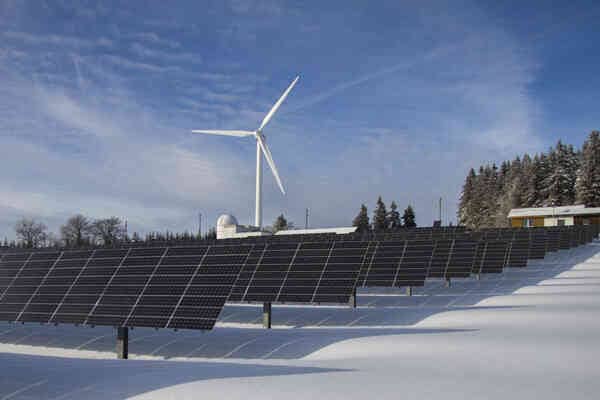
Green Living (also known as Sustainable Living, Earth Harmony Living, or Net Zero Living), as Appropedia describes, is a lifestyle that aims to reduce a person’s environmental impact and use of the Earth’s natural resources.
People adopting a “green living” often find means to reduce their carbon footprint by altering transportation methods, energy consumption, and even diet.
For example:
- using solar or wind energy to power home appliances
- minimizing meat consumption or going full vegan or vegetarian
- switching to electric cars as they are more eco-friendly than traditional fossil-fueled cars
On the other hand, Sustainable Baby Steps defines green living as finding the balance between conservation and preservation of the Earth’s natural resources and biodiversity with human culture and way of living.
3. Zero Waste
(Our favorite eco-friendly term)
Here’s the deal:
According to the Environmental Protection Agency (EPA), the zero waste movement promotes ideas on reducing the waste we create.
The Going Zero Waste blog also describes the zero waste lifestyle as a practice with the end goal of sending zero trash to landfills.
Zero waste can be achieved by being conscious of what we buy (minimalism) and reusing, recycling, and composting as much trash, we create.
Wikipedia describes zero waste as a set of principles where the goal is waste prevention and living life where you send as little (or zero) trash to landfills, incinerators, or the ocean.
For example, people adopting a zero waste lifestyle often switch to using products that come in plastic-free, recyclable, reusable, and compostable containers.
(e.g., zero bathroom products, zero waste laundry detergents)
4. Minimalism
What is minimalism?
According to the Minimalists themselves (Joshua Fields Millburn and Ryan Nicodemus), minimalism is a tool to rid yourself of life’s excess in favor of focusing on what’s truly important.
(Okay, that’s a little vague)
The Merriam-Webster dictionary defines minimalism as:
“a style or technique (as in music, literature, or design) that is characterized by extreme spareness and simplicity.”
Hence, a minimalist lifestyle (also known as a minimalism lifestyle) is living simply with as little material possession as you can.
Minimalism is considered by many to be an eco-friendly practice.
For starters, buying and owning less stuff reduces your impact on the environment.
The fewer purchases you make, the fewer items need to be shipped, and fewer boxes, bags, and packing materials need to be recycled or dumped in landfills.
And when you own fewer things, you not only produce less waste but also consume less of Earth’s natural resources.
5. Certified Organic
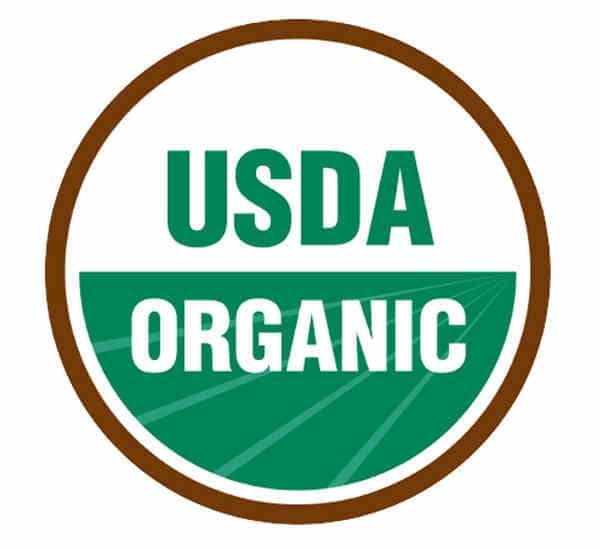
Certified organic products are produced, stored, processed, handled, and marketed in strict compliance with the standards set by an organic certification body.
For example, USDA-certified organic products are produced using ingredients grown on soil with no prohibited substances (including most synthetic fertilizers and pesticides) applied for three years before harvest.
(e.g., certified organic baby shampoos)
The USDA or the United States Department of Agriculture is a federal agency that implements policies and regulations related to American farming, forestry, ranching, food quality, and nutrition.
In most cases, organic products are produced without using synthetic pesticides, fertilizers, or other genetically modified components (GMOs).
Other organic certifying bodies worldwide include:
- Ecocert Certification
- The Organic Materials Review Institute (OMRI) Certification
- California Certified Organic Farmers (CCOF) Certification
- International Federation of Organic Agriculture Movements Certification (IFOAM)
- Quality Assurance International (QAI)
- Nature’s International Certification Services (NICS)
6. Fair Trade
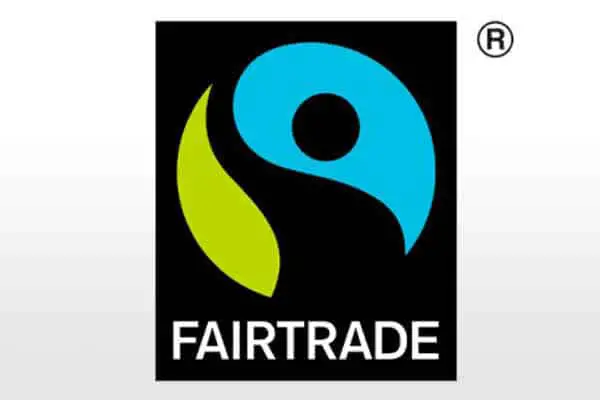
Fair Trade (also known as Fairtrade) is an organized social movement that provides ethical trade arrangements to help product producers achieve sustainable and equitable trade relationships.
In layman’s terms, Fair Trade ensures that producers (e.g., farmers, workers, laborers) are paid fair prices and offered better trading conditions for their goods to support sustainable production.
Besides fair trading prices, Fair Trade also supports ethical production of goods where workers are not exploited and are provided with a nurturing and safe working environment.
That means Fair Trade certified products are produced with no slavery, forced or child labor.
The Fair Trade mark is often found on exports from developing countries such as cocoa, sugar, tea, coffee, honey, cotton, fresh fruit, wine, flowers, handicrafts, and chocolate.
(e.g., Fair Trade chocolate brands)
Fair Trade also helps provide farmers with climate-friendly farming techniques, clean water, educate the children in the producer’s communities, among others.
7. Lyocell or Tencel
Lyocell is a word you’ve probably seen a lot in the labels of your favorite sustainable clothes and textiles.
But what is lyocell?
Lyocell fiber (also known as Tencel) is a type of eco-friendly fabric derived from regenerated cellulose of wood pulps.
Lyocell is the fabric’s generic name, while Tencel is a widely popular lyocell brand sold by Lenzing AG.
The “cel” comes from it being a cellulosic fiber while the “ten” stands for tenacity, hence, Tencel.
Lyocell is classified as a subcategory of rayon.
However, the method to produce lyocell is different from that of rayon fiber.
Lyocell is produced from sustainably sourced natural wood such as eucalyptus and bamboo, using environmentally responsible fiber production.
(e.g., bamboo lyocell)
Furthermore, lyocell is produced using an organic solution of amine oxide (N-Methylmorpholine-N-oxide (NMMO).
On the other hand, rayon is produced using caustic chemicals such as Sodium Hydroxide (caustic soda), Sulfuric Acid, and Carbon Disulfide.
8. Silicone
Silicone is a synthetic material used as an alternative to plastic.
It is primarily derived from silica or Silicon dioxide, the principal constituent of sand.
Silicone is more eco-friendly than plastic given that:
- Silicone is derived from a more sustainable raw material, silica, one of the most abundant minerals in the Earth’s crust
- Pure silicone doesn’t degrade into small pieces, which makes it ocean-friendly; plastic creates microplastics that can harm the oceanic ecosystem
- In general, silicone is more durable than plastic
However, silicone is not biodegradable but can be recycled in silicone recycling facilities.
9. PLA
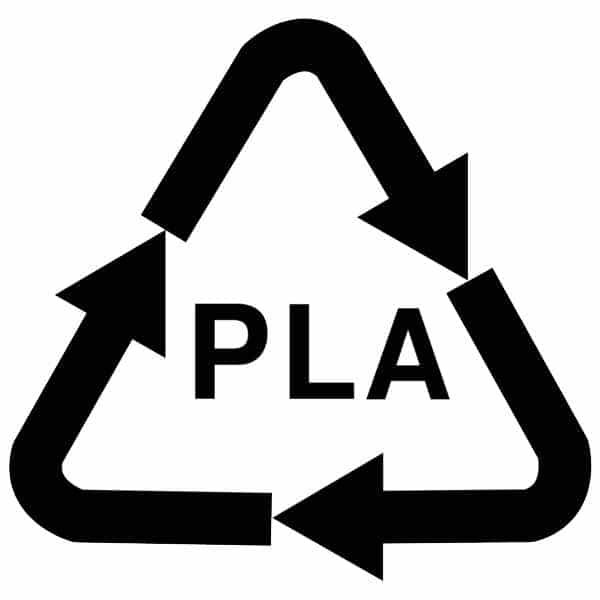
PLA (also known as polylactic acid or polylactide) is a kind of plastic made using plant-based materials – specifically from the starch of corn and sugarcane.
And did you know that PLA is also referred to as a bioplastic?
This stems from the fact that it is produced from renewable biomass sources.
Contrary to other petroleum-based plastics, PLA is arguably more eco-friendly and sustainable given that it is made using sustainable raw materials.
PLA is also compostable in a commercial composting facility, given the specific and controlled composting conditions.
But what about PLA plastics with number 7 on their symbol?
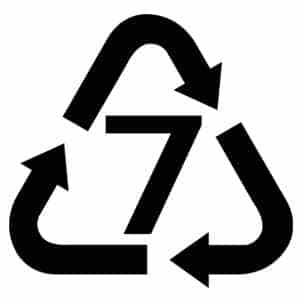
The PLA symbol with a number 7 on it stands for Code 7, compostable plastic.
Compostable plastics are plastics that have been tested and certified by a recognized third party to adhere to international biodegradation standards, such as ASTM D6400 in the USA and the EN 13432 for Europe.
Compostable plastics like PLA are made from various biodegradable materials, including plant starch, cellulose, soy protein, lactic acid, and sometimes petroleum.
You might also be thinking:
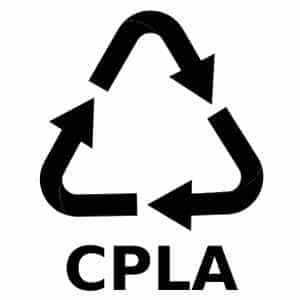
What is CPLA?
CPLA is a form of PLA plastic that has is crystallized for added strength and heat resistance.
Like PLA, CPLA is made entirely from plant-based materials and is also compostable in industrial facilities.
10. Post-Consumer Recycled Plastic
Some eco-friendly product brands (such as eco-friendly laundry detergents) tout their packaging and containers made from Post-Consumer Recycled Plastic.
But what is Post-Consumer Recycled Plastic?
Post-Consumer Recycled Plastic is new plastics made from discarded plastic wastes such as water bottles that have been cleaned and reprocessed in layman’s terms.
Plastics made from post-consumer materials are eco-friendly as they allow plastic waste to be reused rather than dumped in landfills.
This is important considering only ~10% of plastic products and waste are recycled.
11. Biobased Product
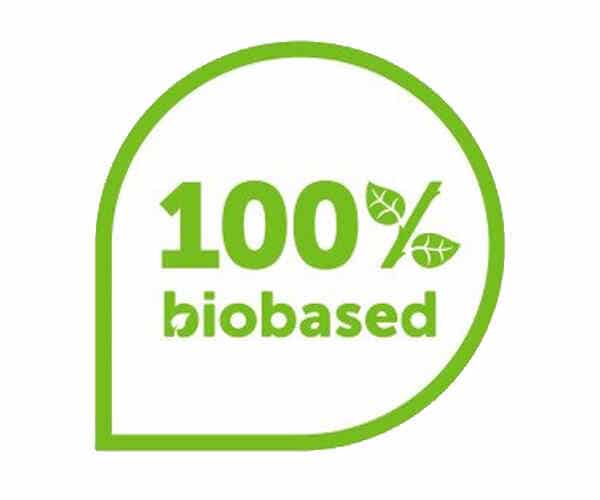
The eco-friendly term bio-based product refers to products wholly or partly derived from plants, animals, trees, and other forestry materials.
For example, PLA is a biobased plastic.
Bio-based materials are often biodegradable or compostable.
12. Biodegradable
Biodegradability is the ability of materials to naturally decompose in the environment with the action of bacteria, algae, fungi, and other microorganisms.
In general, materials are considered biodegradable if they completely break down and decompose into natural elements within a year or less after disposal.
Some of the most widely known biodegradable materials are food waste (like meat, vegetables, and fruits), paper, dead plants and animals, eggshells, etc.
13. Compostable
Compost is a nutrient-rich mixture made of decomposed organic matter such as food waste, animal manure, and garden waste.
Hence, a product is “compostable” if it degrades into nutrient-rich compost when exposed to specific conditions such as the correct balance of microbes, moisture, oxygen, and temperature – all within a particular time frame.
Compostable materials cause no harm to the environment as it breaks down to its natural elements.
14. Recyclable
Recyclable materials can be broken down at the end of their life cycle and reused to make a new product.
For example, some of the most common types of recyclable materials include:
- Plastic
- Silicone
- Metal
- Cardboard
Recycling is an eco-friendly activity as recycled products require less raw resources to produce than those made from new materials.
And by recycling, less waste is sent to landfills and incinerators.
15. Upcycling
Google defines upcycling as the practice of reusing discarded objects or material in such a way as to create a product of higher quality or value than the original.
Meanwhile, Upcycle That defines upcycling as:
“taking something that’s considered waste and repurposing it.”
Upcycled items often become more functional or beautiful than what they previously were.
For example, a reusable face mask made using deadstock fabric, or a bottle opener and bottle cap collector made from discarded snow skis and aluminum cans.

You can also check out our list of unique upcycled gift ideas here.
16. Carbon Footprint
Carbon footprint is the amount of greenhouse gas emissions created by a person, product, business, or industry.
The amount of carbon footprint you create depends on the amount of carbon emitted due to your activities such as eating, using appliances, driving your car, etc.
Carbon footprint is generally measured in tonnes of carbon dioxide equivalent (CO2e).
Meanwhile, a product’s carbon footprint is the number of carbon emissions from cultivating/gathering its raw materials, shipping, and final disposal.
For example, product B, which is flown to the US from Singapore, has a larger carbon footprint from shipping than product B, which is shipped directly to Denver from LA.
17. Carbon Neutral
Carbon neutrality, also known as Net-Zero Carbon or Climate Neutrality, refers to a practice of achieving net-zero carbon dioxide emissions.
In simpler terms, being carbon neutral means you, a business operation, or some other entity removes the same amount of carbon dioxide that you emit into the atmosphere.
For example, you can achieve carbon neutrality as an individual by:
- installing solar panels to your home
- switching to an electric vehicle
- reducing your meat consumption
- going full vegan or vegetarian
- adapting a zero waste lifestyle
Carbon dioxide is one of the greenhouse gasses that are responsible for the increase in average temperatures worldwide.
Hence, practicing a carbon-neutral lifestyle means that you can help address the problem of climate change.
You can also achieve carbon neutrality by purchasing carbon offsets.
18. Carbon Offset
A lot of establishments today, airline companies, in particular, offer carbon offset schemes and programs.
Many eco-friendly underwear and clothing brands also offers carbon offsets.
How does it work?
Basically, you buy carbon offsets and you’re paying money for the reduction of carbon emissions all over the world.
Most carbon offset schemes involves funding reforestation, simple tree planting, renewable energy projects, and reducing air pollution.
With carbon offset schemes, both average individuals and big companies can invest in various environmental projects to negate their own carbon footprints.
Buying carbon offsets is voluntary, and carbon offset prices can be anywhere from $0.10 per tonne to $45 per tonne of carbon dioxide.
19. Septic-Safe
Septic-Safe products don’t contain harsh chemicals that can harm the microorganisms and bacteria that help break down waste in septic systems.
In most cases, septic-safe products are made with natural ingredients and will completely biodegrade within the tank without affecting the bacteria.
For example, many eco-friendly laundry detergents and bamboo toilet papers are septic-safe.
20. Renewable Energy
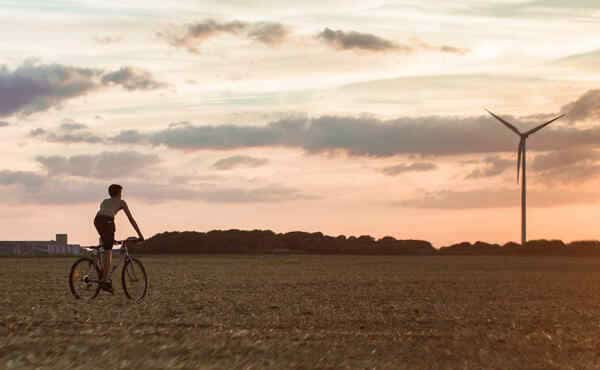
Renewable energy, also known as clean energy, is defined by the Natural Resources Defense Council (NRDC) as the energy that comes from natural sources or constantly replenished processes.
For example, solar energy comes from sunlight which is always shining – although their availability depends on time and weather.
Clean energy is the opposite of nonrenewable, or “dirty,” energy from fossil fuels such as oil, gas, and coal.
Other types of renewable energy sources include:
- Wind
- Hydropower (water)
- Geothermal (energy derived from the heat that comes from the sub-surface of the earth)
- Biomass
- Wood and wood waste
- Municipal solid waste
- Landfill gas and biogas
- Biodiesel
21. Vegan
Veganism is a lifestyle that centers around the complete avoidance of consuming animal products, particularly in diet and clothing.
It has something to do with the philosophy of avoiding all forms of exploitation of, and cruelty to, animals.
Hence, a vegan person does not eat meat and any food derived from animals, nor use accessories such as bags made using animal skin.
By the same principle, vegan products doesn’t contain meat and any animal by-products.
And if you’re wondering how veganism is good for the planet, click here.
22. Cruelty-Free
Cruelty-free are products, ingredients, and materials that are not tested on animals.
23. Vegetarian
Similar to veganism, vegetarianism is the practice of not eating animal meat.
However, vegetarians may consume animal by-products such as milk, cheese, caviar, and eggs.
24. SLS Free
An SLS-free product does not contain the harsh personal care product ingredient sodium lauryl sulfate (SLS), a foaming agent that can cause skin irritations and can harm aquatic life.
25. 6 R’s
Refuse, Reduce, Reuse, Repurpose, Recycle, and Rot.
- Refuse: Say no to things that you don’t need.
- Reduce: Minimize the amount of stuff you buy to create less waste – stick to the essentials.
- Reuse: Repair and find new uses of things before deciding to throw them away.
- Repurpose: Find ways to upcycle old items and convert the otherwise waste materials into new useful things.
- Rot: Compost
- Recycle: Send plastic, silicone, and other nonbiodegradable and non-compostable waste to proper recycling facilities.
Commonly Interchanged/Misused Eco-friendly Terminologies
Natural vs. Organic Product
Natural products are made without synthetic or artificial ingredients and additives.
On the other hand, organic products are made using natural ingredients grown without artificial pesticides, fertilizers, or herbicides. (see certified organic definition above)
Meanwhile, organic meat, eggs, and dairy products are obtained from animals fed only with natural feed and not given hormones or antibiotics.
Vegetarian vs. Vegan
Vegetarians don’t eat animal meat but may consume and use animal by-products (e.g., eggs, dairy).
Vegans don’t eat nor use any products that have something to do with animals.
Veganism and vegetarianism are considered eco-friendly as meat consumption is considered to be one of the leading causes of carbon emissions.
Animal agriculture is among the top 3 causes of greenhouse gases worldwide, hence a plant-based diet is better for the planet.
Biodegradable vs Compostable
One of the main differences between biodegradation and composting is that biodegradation is naturally occurring, whereas composting always requires human input.
Second, compostable products require a specific setting to break down, whereas biodegradable products break down naturally in the environment after disposal.
Third, compostable materials provide the earth with nutrients (compost) once the material has completely broken down; biodegradable materials may not.
Recycling vs. Upcycling
Recycling requires breaking down an old material (or waste) for it to become reusable.
For example, when plastic is recycled, it will be melted down and then made into a new product.
Meanwhile, upcycling is a creative process where waste and old materials are reused immediately to create a brand new product.
For example, discarded disposable face masks upcycled as plant pots or personal hair scrunchies.
Nevertheless, both recycling and upcycling are important eco-friendly practices as they provide means to reuse old materials instead of throwing them away to landfills.
Conclusion
As society is getting more involved in different ways to protect the planet, almost all products have the word “eco-friendly” (or some kind of eco-friendly term) slapped on their labels.
With this list of 25 eco-friendly terms and their meaning, we hope we made it easy for people like you to familiarize the jargons that come with an eco-friendly lifestyle.
And if there are more eco-friendly terms that confuse you, let us know in the comment section below.
Anyways, which of the eco-friendly term meanings above surprised you the most?
Which ones you already know?

